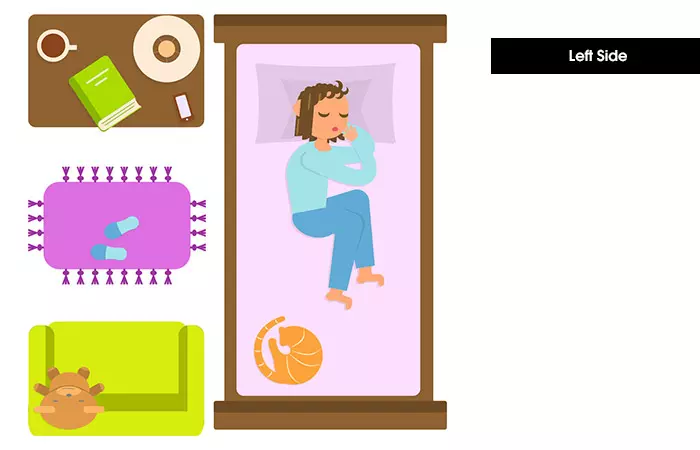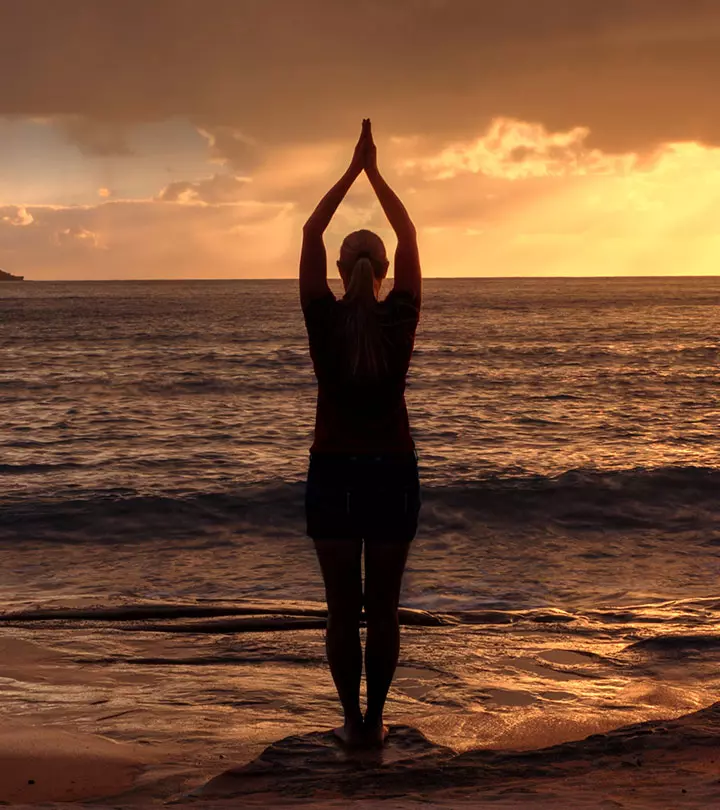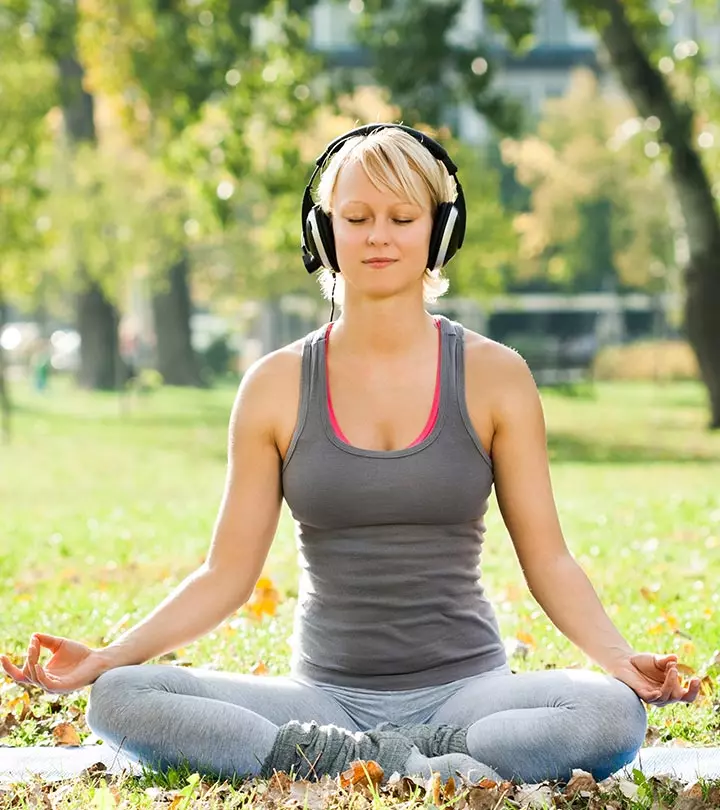5 Types Of Sleeping Positions And Which Are The Best And Worst
Wrong sleeping positions can keep you up all night and leave you with aches and fatigue.

Image: Shutterstock
Sleeping well is not easy. Bad posture, an uncomfortable bed, and a buzzing mind can keep you up all night, and you wish you could do something about it. How well you sleep depends on how your day goes by and the manner you prepare for sleep. Most importantly, the position you sleep in matters a great deal. Knowing more about the various sleeping positions is important for both comfort and preventing health problems related to improper sleeping posture. To know more about them and their various pros and cons, keep reading.
Before that, let’s find out about the importance of sleep.
In This Article
Why Is Sleeping Well Important?
Sleeping peacefully every day for 6 to 8 hours is necessary for a healthy body and mind. A sound sleep will allow your brain to prepare for the next day and gear you up to learn and remember new information. Adequate sleep gives your body an opportunity to heal and repair the heart and the blood vessels, protecting you from heart diseases and high blood pressure.
A good sleep rests your body and helps it to build a healthy immune system. And, in general, the kind of sleep you have will decide your mood the following day. It also has an effect on the way you think and react. Therefore, an individual who sleeps well is more attentive, makes better decisions, and is more creative and healthy.
 Quick Tip
Quick TipNow, let’s find out the different positions we sleep in and which works best for your health.
Key Takeaways
- Peaceful sleep (6 to 8 hours uninterrupted) will allow your body to rest well, improve your immune system and brain function, and protect you from high blood pressure and heart diseases.
- You should sleep on your back or on your left side to help reduce pressure on the neck and back.
- You must also avoid sleeping on your right side as it can strain your heart and lungs and impede blood circulation, making you move to adjust yourself, thereby interrupting your sleep.
- You should avoid sleeping on your stomach as it can put a strain on the neck and spine, place your head in an awkward and painful position and flatten the curve of your spine, leading to lower back pain.
Types Of Sleeping Positions
- Sleeping On The Stomach
- Sleeping On The Sides (Right Side And Left Side)
- Sleeping With The Legs Up
- Sleeping On The Back
1. Sleeping On The Stomach

There are days when after a long day of work, all you want to do is fall flat on the bed and doze off. Well, tucking your face into the pillow might be comforting, but in the long run, it doesn’t do much good for you.
Pros: The only good thing about sleeping on the stomach is that it eases snoring.
Cons: Sleeping on the stomach leads to waking up in the morning with pain and discomfort. It strains your neck, places your head at an uncomfortable angle, and pulls your belly down. It flattens the natural curve of your spine and leads to lower backache. Your sleep position can also affect your posture throughout the day, so trying exercises to improve posture may help balance the impact of your sleeping habits. Sleeping on the stomach is not recommended during pregnancy.
Tip: Sleeping on the stomach is considered the worst sleeping position, and experts recommend you gradually shift to sleeping on the side with the help of pillows.
2. Sleeping On The Sides
Studies prove that most people prefer to sleep on their side. It could either be curled up in a foetal position or a relatively straighter angle. The side you sleep on also makes a difference. Sleeping on the right side does not have the same effect as sleeping on the left. Each has its unique benefits and side effects. Check below to find out.
Right Side

Pros: Sleeping on your right allows your spine to relax in its natural curve.
Cons: If you sleep on your right side, you are constricting your entire cardiovascular system as it lies on the right side of your body. This sleeping position strains the lungs and compresses the rib cage. It hampers blood circulation, making you move during your sleep to balance out the distribution. Avoid this position if you can, and opt to sleep on your left side.
Left Side

Pros: Sleeping on the left side alleviates acid reflux and heartburn. However, it can put too much pressure on the stomach. During pregnancy, it is recommended to sleep on the left side as there is less pressure on the inferior vena cava.
Cons: If you curl up too much, it restricts deep breathing.
A study was conducted on 761 participants to find if there is a link between one’s sleeping position and glenohumeral (shoulder joint) pain. Participants were found to be 2.06 times more likely to sleep on their right side if they had left shoulder discomfort, while they were 0.64 times more likely to sleep on their left side if they experienced pain on their right shoulder.
Tip: To make your side sleeping position better, place pillows between your knees to align your body correctly between your hips and the joints.
 Did You Know?
Did You Know?3. Sleeping With The Legs Up

While you sleep, your legs have a tendency to move up and down. Quite often, you wake up to see your legs pulled up closer to your chest. It could either be one leg higher up than the other or both pulled upwards.
Pros: Sleeping with both legs up takes the weight off the pelvis area and is helpful for those suffering from backache.
Cons: Sleeping with one leg up causes unevenness in the body and is damaging to the pelvis. It leads to a backache.
Tip: To prevent your feet from cycling while you are asleep, place a medium-sized thick fluffy pillow in between your legs. The pillow will make it difficult for your legs to move up and down.
4. Sleeping On The Back

Sleeping on the back is the best way to sleep. In this position, your face is facing straight, and the back of your head is resting on a pillow. The pillow elevates your head slightly, placing your stomach below the food pipe. This sleeping position works best for your health.
Pros: Sleeping on the back distributes body weight evenly on the spine and protects your face from wrinkles that come from digging your face into a pillow. It eliminates any possibility of acid reflux or food coming back up the digestive tract. It is pain-free and comfortable.
Cons: This sleeping position is not good for those who snore. The throat and stomach are pulled down by gravity, which makes breathing difficult.
Tip: Add soft and comfortable pillows to your bed. Keep one or two below your head to align your body properly.
Talk to a healthcare professional as they can give you personalized advice on how to improve your sleeping position. This is particularly helpful for individuals dealing with chronic pain or specific health issues, as they can recommend adjustments to help you sleep more comfortably and reduce discomfort.
Your sleeping position is crucial, as it determines how rested you will feel when you wake up the next morning. In fact, a specific sleeping position may also help you deal with back pain. Learn more in the next section.
Best Sleeping Position For Back Pain
Fetal Position
The fetal position involves curling your body into a round shape, resembling the position of a fetus in the womb (1). Lie on your side with your knees drawn up to your chest and your chin slightly tipped down.
Pros: This position may relieve back pain by reducing the pressure on your spinal discs. It helps maintain the natural curvature of the spine and is especially beneficial for people with lower back pain.
Cons: Curling up too tightly in this position may lead to joint pains.
Tip: Place a pillow between your knees to support your lower back and hips.
In addition, there are a variety of sleeping positions that people commonly adopt during the night. They include soldier, freefall, starfish, yearner, prone, sprawled, bent, supine, inclined, reclined, slouched, hunched, and propped-up. Each sleeping position can have an impact on the quality of sleep and comfort levels. Moreover, if you struggle with sleep disorders like sleep apnea, knowing the correct sleeping position can help. Also, including some home remedies for sleep apnea is a good idea as it might improve your nighttime breathing and overall sleep quality.
Infographic: Pros And Cons Of Different Sleeping Positions
Your sleeping position can determine the duration and quality of your sleep. While some prefer sleeping on their backs, others prefer sleeping on their sides. But are all of them good for your sleep hygiene and overall health? Check out the infographic below to learn about the pros and cons of different sleeping positions.
Some thing wrong with infographic shortcode. please verify shortcode syntaxSound sleep is something everybody needs. However, bad sleeping positions can deprive people of good sleep. Sleeping on the back and on the left side has more pros than cons, so you can try adopting these postures. Sleeping on the stomach may help stop snoring but may cause stomach discomfort, strain the neck, and flatten the spine’s natural curve. Similarly, sleeping on the right side may help the spine relax, but you may end up straining your entire cardiovascular system and lungs besides hampering blood circulation. Sleeping with the legs up may damage the pelvis and cause unevenness in the body. So, opt for sleeping on the back to improve sleep quality and wake up fresh and rejuvenated.
Frequently Asked Questions
How much sleep does an average person need?
The number of hours of sleep differs from person to person. But, on an average, 6-8 hours of sleep at night works well for many individuals.
What should people who work in the night do to sleep better during the day?
If you are sleeping in the day to make up for the night, make sure you create an environment in your room that is similar to that of night. Make your room dark and cool. The ideal temperature is 18oC. Sleep on a comfortable mattress and ensure silence.
Does exercise help you sleep better?
Yes, exercise helps you sleep better. People who exercise a few times a week tend to sleep better than those who do not.
How do we know if we have a sleep disorder?
If you feel sleepy even after a proper night’s sleep without any disturbances, consult a doctor to check if you are suffering from a sleep disorder.
Is napping good for me?
Taking short naps during the day can be refreshing, but if you feel like napping all the time, you might not be getting adequate restful sleep at night. Similar to other bodily functions, sleep is essential for your overall well-being. A good night’s sleep will go a long way in keeping you hale and healthy. You must do whatever it takes to try and sleep well. Begin by getting your sleeping position right.
What is the most common sleeping position?
Side sleeping is one of the most common sleeping positions.
Is sleeping naked better for your health?
Sleeping naked can have many positive health effects. The primary reason is that sleeping without clothes can help your body cool down effectively, which sends signals to your body’s circadian rhythm. This helps you fall asleep faster and improves your sleep quality (2).
What sleeping position is the best for your brain?
Research suggests that sleeping on the side helps improve the brain’s glymphatic system, which removes waste from the brain. This waste is linked with neurodegenerative diseases, such as Alzheimer’s disease. Hence, a better cleaning system may exert a protective effect against them (3).
Is it OK to sleep without a pillow?
Sleeping without a pillow may put pressure on the back and neck, especially in a side sleeping position. However, those who sleep on their stomach may do so if that is more comfortable for them.
Illustration: Types Of Sleeping Positions And Which Are The Best And Worst

Image: Stable Diffusion/StyleCraze Design Team
Optimize your health with the right sleeping positions. Learn how to improve your sleep quality and overall well-being. Watch the video and start prioritizing your restful nights now.
References
Articles on StyleCraze are backed by verified information from peer-reviewed and academic research papers, reputed organizations, research institutions, and medical associations to ensure accuracy and relevance. Read our editorial policy to learn more.
- Sleeping Position and Back Pain
https://www.researchgate.net/publication/340684226_Sleeping_Position_and_Back_Pain - Effects of thermal environment on sleep and circadian rhythm
https://www.ncbi.nlm.nih.gov/pmc/articles/PMC3427038/ - The Effect of Body Posture on Brain Glymphatic Transport
https://www.ncbi.nlm.nih.gov/pmc/articles/PMC4524974/
Read full bio of Gaelle Clement
Read full bio of Shirin Mehdi
Read full bio of Ravi Teja Tadimalla
Read full bio of Himanshi Mahajan

























Community Experiences
Join the conversation and become a part of our empowering community! Share your stories, experiences, and insights to connect with other beauty, lifestyle, and health enthusiasts.